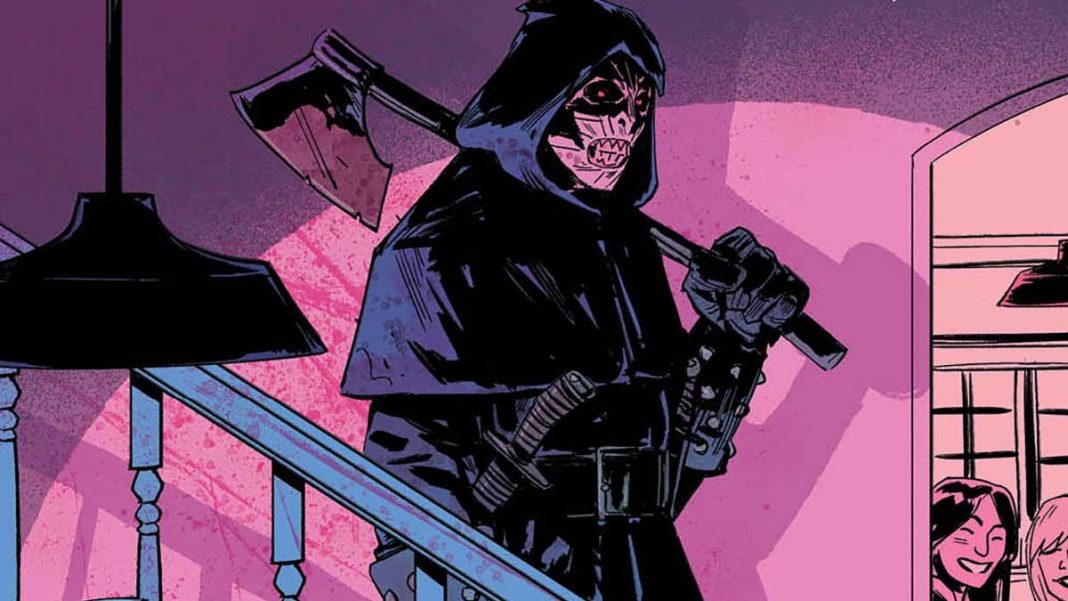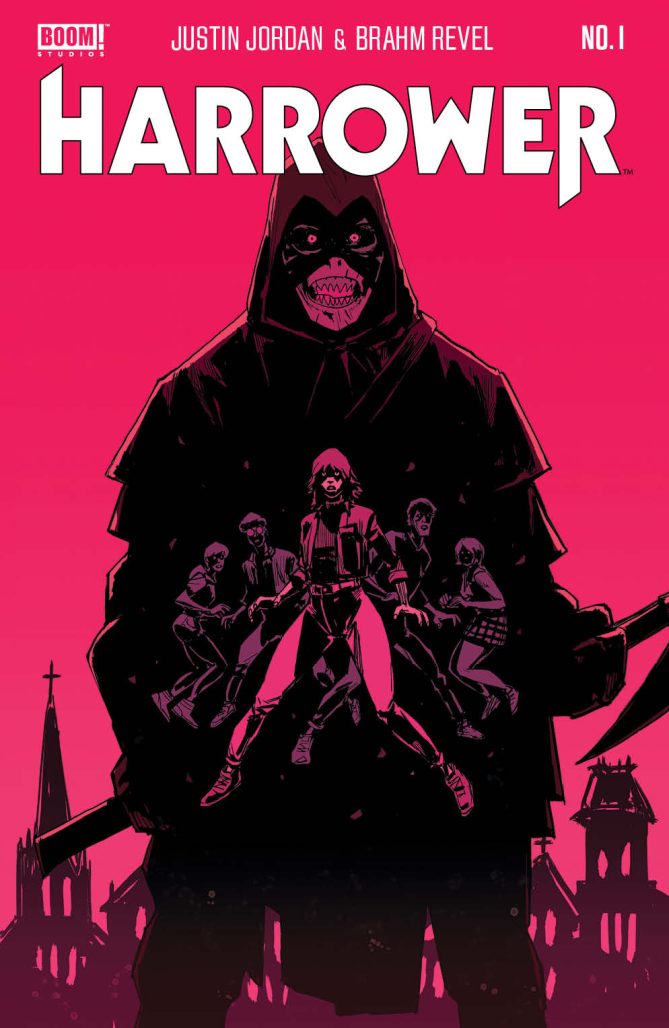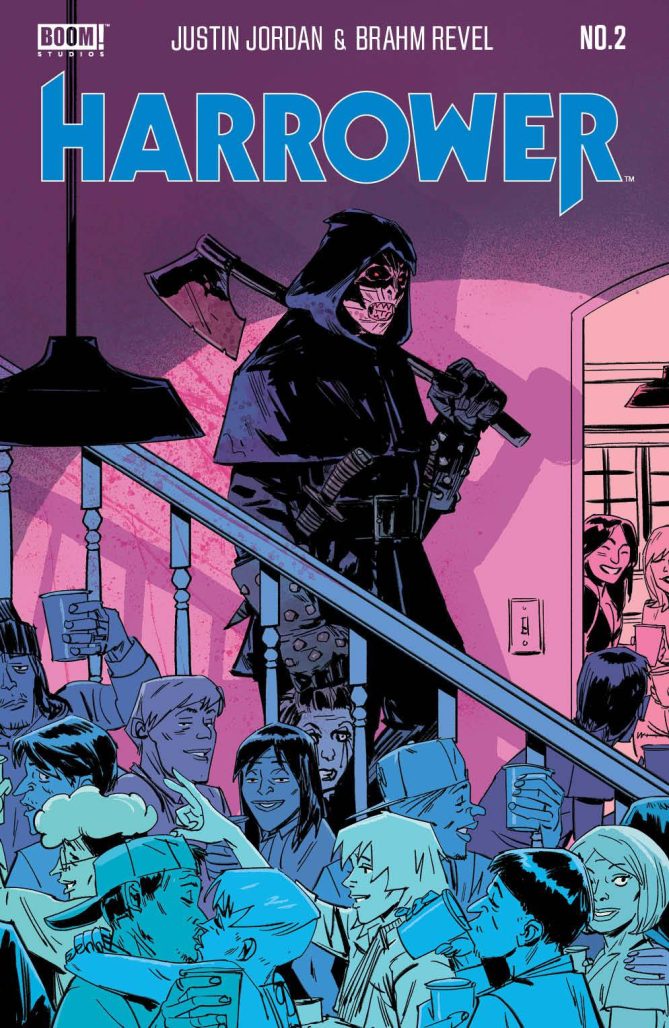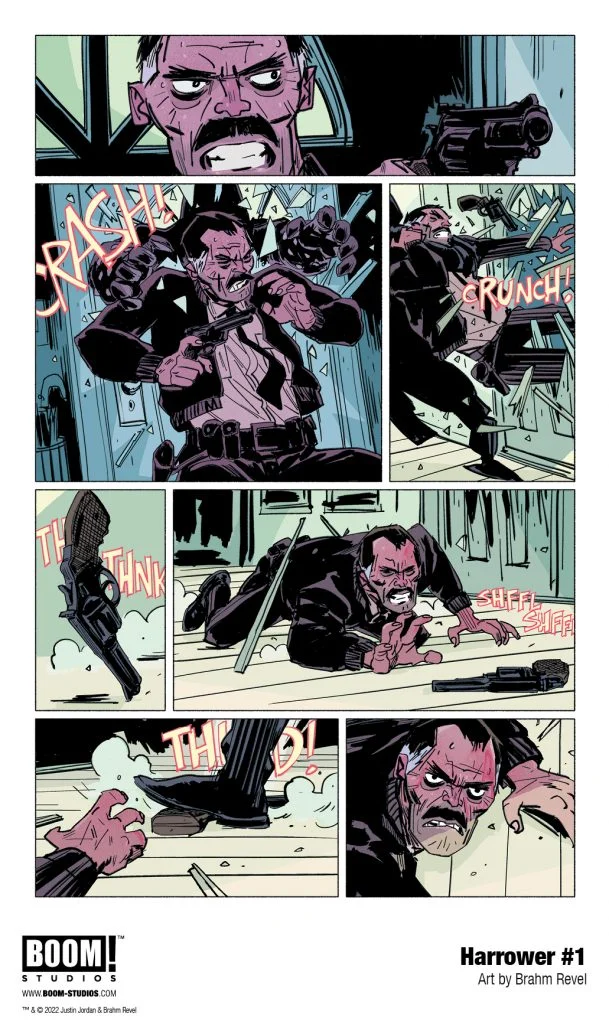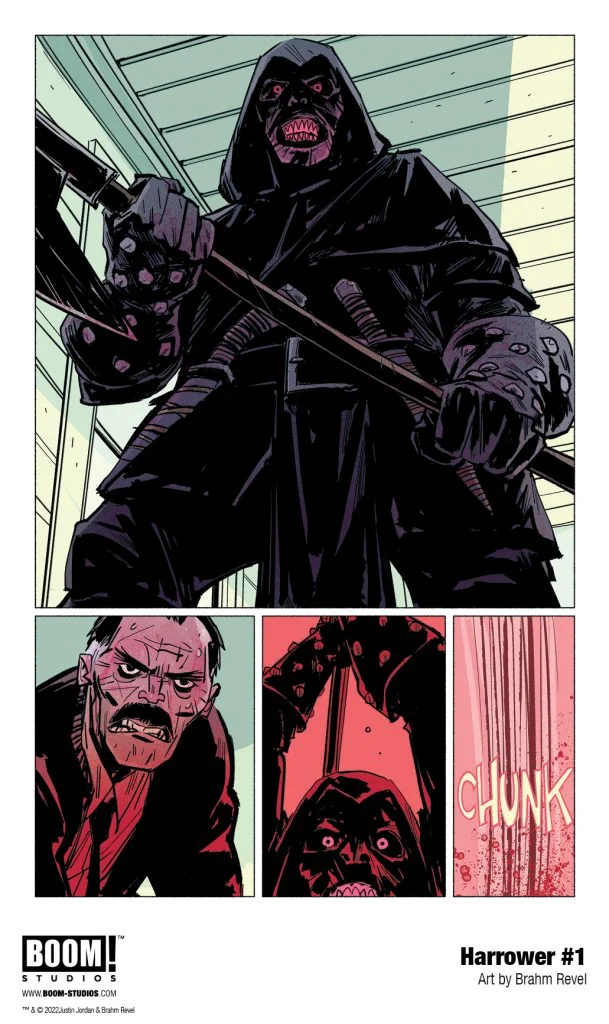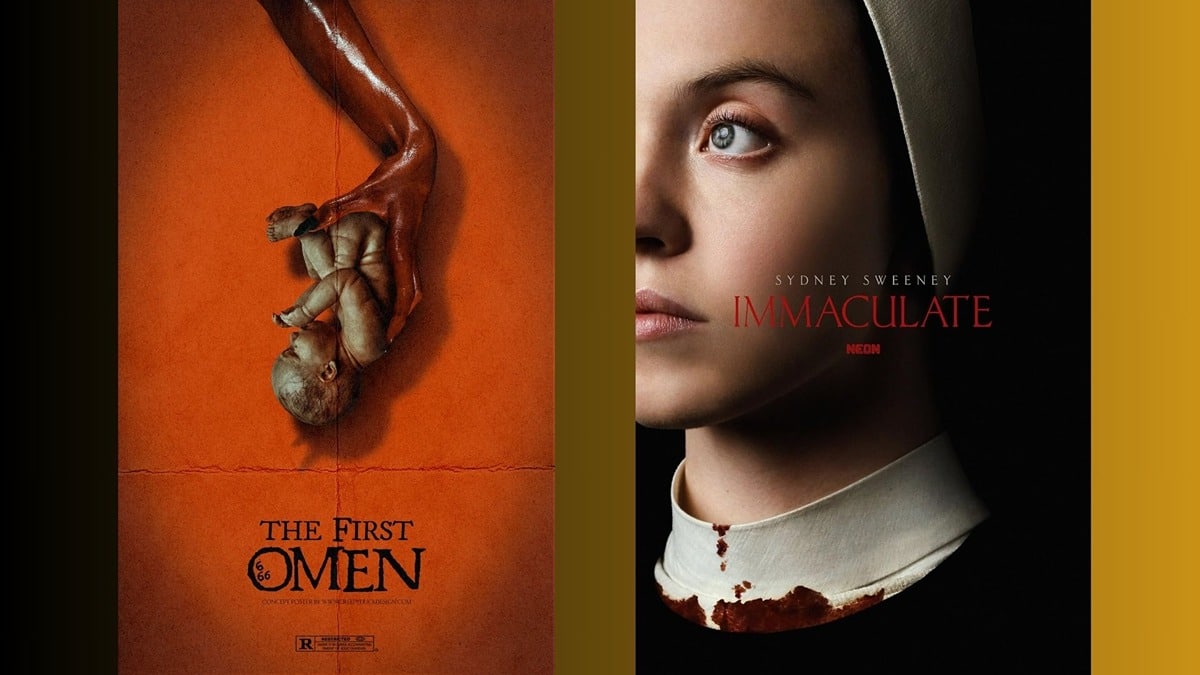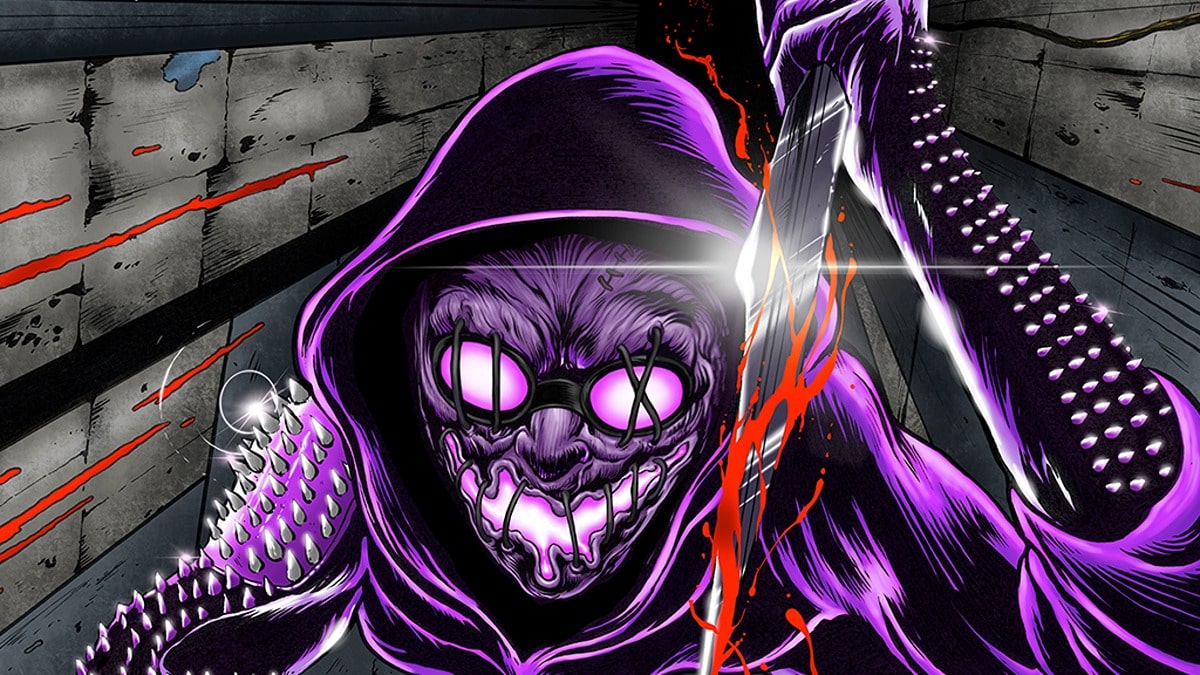Despite the large numbers of slasher movies out in the world, pulling off a great slasher is not an easy task. There are expectations that come with such an endeavor, namely the creation of an iconic killer that’s as inventive with their violence as they are terrifying. Perhaps one of the most underrated aspects of a slasher, though, is their capacity to project an imposing image, to carry a sense of presence and force that audiences should glue their eyes to each time he or she pops up.
Justin Jordan and Brahm Revel manage to produce just that with their comic Harrower, a killer worth following around, but there’s a lot more under the hood to makes this slasher feel different.
Harrower is set in a New York town called Barlowe, a place that holds close to an urban legend about an axe-wielding killer dressed like a medieval executioner that hunts down those who indulge the sins of youthful recklessness and other evils. Those who draw the Sinner’s Mark anywhere on the town, a summoning symbol, is said to bring the Harrower back to continue his mission, cleansing Barlowe of sin.
A group of high schoolers intend to attend a big old Halloween party regardless of the town’s superstitions, an affront to the symbols of their home and their alleged purpose of unifying a community under fear. Little do they know that the Harrower is real and that he has been summoned once more for a fair amount of puritanical bloodletting.
Jordan and Revel have a very vicious slasher on their hands with Harrower, a character that derives his own power from how deadly he looks. He’s dressed in all black, with only part of his face revealed and red piercing eyes making it possible to outline some form or shape in the darkness. He does carry an axe, but the inclusion of chains among his tools gives him a deeper sense of violence, not unlike that which characterizes Hellraiser’s Cenobites. Just this design element alone imbues the Harrower with layers of characterization and extends the mystery behind his existence (which already borrows heavily from Michael Myers and Jason in terms of physicality and how they relate to the towns they hunt in).
The slasher’s victim pool includes the classic batch of oblivious teens that disregard ominous warnings by the town’s elders to go party despite being told they have a high chance of getting an axe to the face. And yet, there’s an interesting twist (that I won’t spoil) that colors these characters somewhat differently. It opens the doors to more inventive interpretations of the slasher formula. All of this to say, Harrower is the kind of slasher you should be paying attention to.
The Beat corresponded with Justin Jordan to get at the roots of the Harrower and to discuss what exactly goes into creating a new slasher.
RICARDO SERRANO: The slasher genre is more adaptable and malleable than people think it is. It has the capacity to create memorable killers that range from the supernatural to the real while still containing a special kind of evil that keeps them in the realm of plausibility (a serial killer is closer to reality than a werewolf, for instance). In which corners of the slasher did you find the inspiration for Harrower?
JUSTIN JORDAN: That’s a surprisingly hard question to answer without spoiling the comic. Certainly, the Harrower appears to be a supernatural figure, and is regarded as such in his universe. But in general, I was drawing from the eighties slashers, when the genre had kind of reached its final form, where you had established concepts like a supernatural element (sometimes), a vengeance aspect (usually), the final girl, and such.
What we’re trying to do, aside from doing a fun slasher movie as a comic, was to take the classic tropes and recontextualize them in a way that wasn’t the sort of meta commentary that Scream was doing. So to talk about in it writery terms, we’re trying to both comment on slashers and provide a good one.
SERRANO: Designing slashers is an integral part of the subgenre and it can either make or break a story. What were you hoping to capture with your killer?
JORDAN: Well, he needed to look iconic. Which Brahm nailed, I think. He’s instantly recognizable, which I think the best slashers are. You recognize Jason, Michael Myers, Freddy at a glance, and that’s what we were trying for with the Harrower.
His look is meant to evoke both a classic executioner’s look as well as evoke a sense of something undead and unnatural. He’s someone you should look at and just think RUN.
SERRANO: There’s a deeper sense of mystery surrounding your slasher, especially as it pertains to how “regular people” relate to him. That isn’t something that’s common within this type of narrative. What made you go that route with Harrower?
JORDAN: While Harrower is first and foremost a slasher, I went pretty broad with what horror elements I was drawing from. So there’s elements of folk horror, ala Midsommar and The Wicker Man, as well as some of the New French Extremity, particular Martyrs, in the DNA.
That grew out of that use of tropes. I’m trying to be vaguely no spoilery here, but it came from asking questions like “Why wouldn’t cell phones work? Why are the police useless? Why can the killer appear from nowhere?” and figuring out answers. And that evolved into something bigger, in terms of the universe of Harrower.
SERRANO: For readers that get inspired to dig deeper into slashers after reading Harrower, what movies or other media would you recommend to further their journey into it?
JORDAN: The original Black Christmas and Halloween are really the ultimate slashers, and they hold up as movies now. I think it’s also worth watching Scream, which is actually a pretty great slasher even outside the metacommentary, and the French films Inside and Martyrs are also worth watching.
SERRANO: Is Harrower a comic you can see yourself turning into a larger universe with branching stories and other killers of its own?
JORDAN: Well, every good slasher has sequels, right…?
The first two issues of the four-issue Harrower are available from BOOM! Studios in stores and digitally now.


